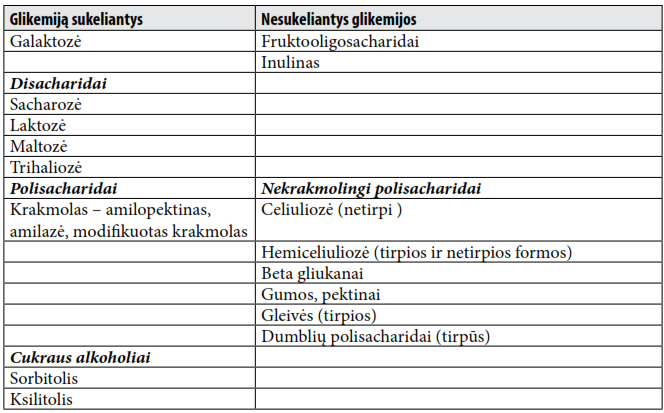Carbohydrates
Carbohydrates are the main source of energy in the daily diet. 1 g of monosaccharides and disaccharides provides the body with 4 kcal. Monosaccharides – glucose, fructose, and galactose, of which glucose is the most important to us. Disaccharides are composed of two monosaccharides, for example, sucrose, polysaccharides (composed of more than 10 disaccharides), for example, starch. Carbohydrates also include sugar alcohols sorbitol and xylitol, which provide 2.4 kcal per 1 g and are used as sweeteners – sugar substitutes – in the production of chewing gums, cereals, and soft drinks. Large amounts can cause osmotic diarrhea.
Fruits and vegetables are characterized by small amounts of free glucose. Fructose is found in honey, fruits. In the food industry, fructose is extracted from corn syrup.
Distribution of Disaccharides
Sugar contains 99% sucrose. This is the most commonly used disaccharide. Sucrose is hydrolyzed into glucose and fructose.
Lactose, also known as milk sugar, is found in milk and dairy products. Lactose gives milk a sweet taste.
Oligosaccharides
Raffinose – a trisaccharide found in sugar beets. Stachyose is found in legumes and seeds. Humans lack the enzymes needed to digest them, but they can be fermented in the colon. It has been shown that fructooligosaccharides, inulin, promote the growth of bifidobacteria in the colon.


Starch
Starch is one of the most important food substances. Long hydrolyzed starch breaks down into glucose. Starch is abundant in cereal grains, tuberous vegetables – potatoes, legumes. It forms various shapes and sizes of granules specific to each type of plant. The largest starch granules are in potatoes, smaller ones are in rye, wheat, barley, and rice. Larger granules gelatinize at a lower temperature, are more resistant to the action of amylase. Starch consists of two polysaccharides: amylose and amylopectin. The bonds between glucose molecules, acted upon by the enzyme amylase, decrease. Food preparation methods affect the breakdown of these bonds and alter the properties of starch, making some types of starch easily digestible, while others pass through the digestive tract undigested. Rapidly and slowly digestible starches are digested in the small intestine, while resistant starch passes undigested into the colon, where it is fermented.

Dietary Fiber (non-starch polysaccharides)
Dietary fibers are classified as soluble and insoluble in water.
Insoluble fibers consist mainly of cellulose and hemicellulose. Insoluble fiber binds with water in the colon and swells. This promotes intestinal peristalsis, reduces the risk of constipation, and the likelihood of colon cancer.
Soluble fibers dissolve and thicken in water. These are pectins, gums, and mucilages. They provide a feeling of fullness, slow down the absorption of bile acids, increase the excretion of cholesterol with feces, and regulate cholesterol levels in the blood. Food sources: beans, peas, oatmeal, oat bran, barley, fruits (apples, cherries, citrus fruits), berries (currants, strawberries, blueberries, blackberries), vegetables (beets, carrots). The amount, composition, and structuredepends on the plant species, ripeness. Pectin is most commonly extracted from citrus fruits. In a weak acidic environment, pectins form gel-like structures, so they are widely used as a thickener in confectionery, jelly, marmalade production, as a filler in medicine, candy production, as well as in juice and milk drinks stabilizer. In addition, pectins easily bind with heavy metal salts, so they are used preventively to avoid heavy metal poisoning.

Recommendations for sugar and dietary fiber intake
The consumption of lactose should not be restricted for adults. It is recommended that easily digestible carbohydrates should not exceed 60 g / day or should not exceed 10% of daily energy value.
It is recommended that adults consume at least 18 g of non-starch dietary fiber per day (12-34 g / day).
Source | Dietary Treatment in General Practice | Dietitian Doctor Jūratė Dobrovolskienė
